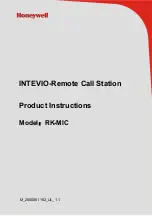
must and we recommend using our R-121, R-122, or R-122V
ribbon microphones.
Specialized Stereo Recording Techniques
Classic Blumlein Technique
For many years, “coincident” microphone setups have been
widely used for picking up sounds in stereo as naturally as possible.
The “Blumlein” technique, named for A.D. Blumlein, involves
the use of two figure-eight microphones positioned as in the
sketch (see Figure 1); one
mic faces left and the other
faces right, at an angle of
90º (i.e., each displaced 45º
from center).
Each microphone ultimately
feeds one speaker in a stereo
system and, due to the
directionality of the
microphones, the result is a
very well defined stereo
image on playback. For
classical music particularly,
the reproduction can be very
satisfying.
The SF-12 stereo microphone is two identical ribbon microphones
in just this Blumlein orientation: if the microphone is
placed in front of the performance, with the Royer logo facing
the center of the ensemble to be recorded, the microphone will
give a stereo recording as per the Blumlein technique. Because
of the togetherness of the SF-12’s ribbon transducers, sound
will arrive at both ribbon elements at the same time. This means
that the two channels can be summed to mono with no comb
filter effects, and room reverberation (undesirable in mono) is
cancelled to a surprising degree.
For the sake of clarity, engineers commonly refer to similar
stereo miking with cardioid mics as “X-Y.” When figure-8’s are
used, it is more commonly referred to as “Blumlein” recording.
Figure 1
12
Содержание SF-12
Страница 20: ...Notes 19 ...







































